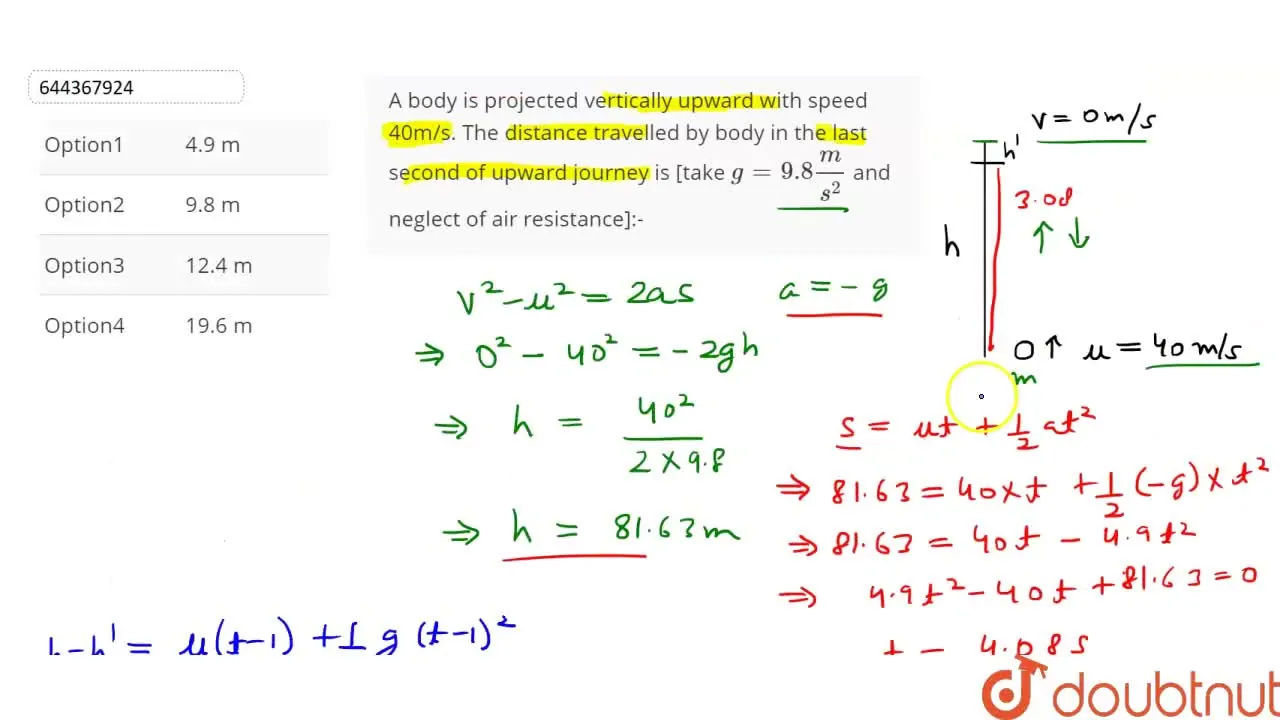A body is projected vertically upward with speed 40m/s. The distance travelled by body in the last second of upward journey is [take g=9.8ms2 and neglect of air resistance]:-
4.9 m
9.8 m
12.4 m
19.6 m
The correct Answer is:A
Step by step video & image solution for A body is projected vertically upward with speed 40m/s. The distance travelled by body in the last second of upward journey is [take g=9.8m/s^(2) and neglect of air resistance]:- by Physics experts to help you in doubts & scoring excellent marks in Class 12 exams.
Related Playlists
- BOOK - AAKASH INSTITUTE ENGLISHCHAPTER - MOTION IN A STRAIGHT LINEEXERCISE - ASSIGNMENT (SECTION - B)33videos
MOTION IN A STRAIGHT LINE
- BOOK - AAKASH INSTITUTE ENGLISHCHAPTER - MOTION IN A STRAIGHT LINEEXERCISE - ASSIGNMENT (SECTION - C)36videos
MOTION IN A STRAIGHT LINE
- BOOK - AAKASH INSTITUTE ENGLISHCHAPTER - MOTION IN A STRAIGHT LINEEXERCISE - EXERCISE29videos
MOTION IN A STRAIGHT LINE
- BOOK - AAKASH INSTITUTE ENGLISHCHAPTER - MOTION IN A PLANEEXERCISE - Assignement section -J (Aakash Challengers Questions)7videos
MOTION IN A PLANE
- BOOK - AAKASH INSTITUTE ENGLISHCHAPTER - MOTION IN STRAIGHT LINEEXERCISE - Assignment (SECTION - J)2videos
MOTION IN STRAIGHT LINE
Similar Questions
A ball is projected vertically up with speed 20 m/s. Take g=10m/s2
View SolutionA body is projected with a velocity 60ms−1 vertically upwards the distance travelled in last second of its motion is [g=10ms−1]
View SolutionA body is thrown vertically upward with velocity u. The distance travelled by it in the 7thand8th seconds are equal. The displacement in 8th seconds is equal to (take g=10m/s2)
View SolutionA body is projected vertically upward with speed 10m/s and other at same time with same speed in downward direction from the top of a tower. The magnitude of acceleration of first body w.r.t. second is {take g=10m/s2}
View SolutionA body is thrown vertically upwards and takes 5 seconds to reach maximum height. The distance travelled by the body will be same in :-
View SolutionA body is thrown up with a velocity 29.23ms−1 distance travelled in last second of upward motion is
View SolutionThe distance travelled by a body during last second of its upward journey is d when the body is projected with certain velocity vertically up. If the velocity of projection is doubled, the distance travelled by the body during last second of its upward journey is
View SolutionA particle is projected vertically upwards with velocity 40m/s. Find the displacement and distance travelled by the particle in
(a) 2s (b) 4s (c) 6s Take g=10m/s2View SolutionSTATEMENT - 1 : Two bodies projected vertically upward with different initial speeds cover same distances in last second of their upward journey.
and
STATEMENT - 2 : For uniformly accelerated motion, distance travelled in a time interval before coming to rest does not depend on initial speed.View SolutionA particle is projected vertically upwards with a velocity of 20m/sec. Find the time at which distance travelled is twice the displacement
View Solution


